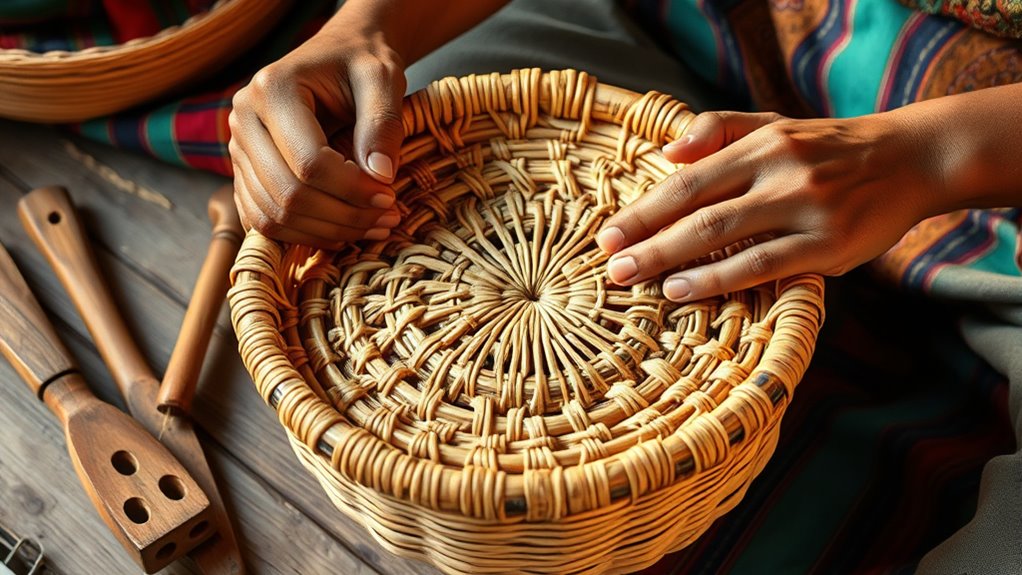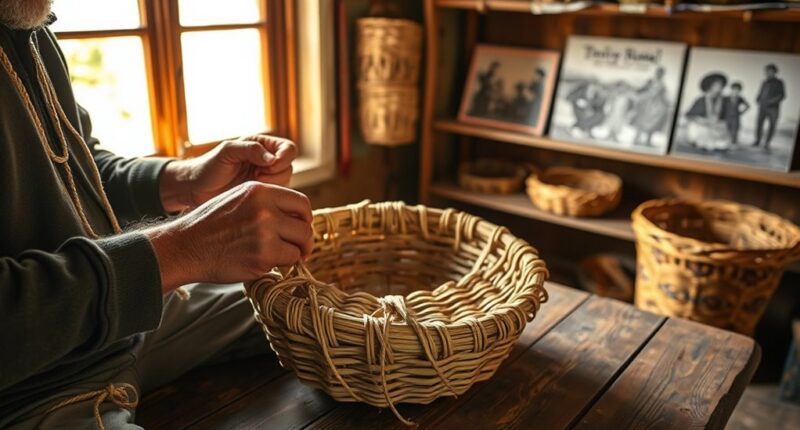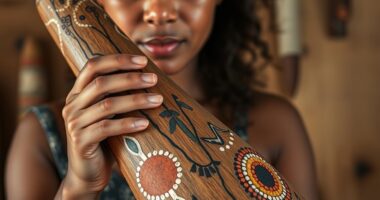To revive basket weaving traditions, focus on classic techniques passed down through generations, such as specific weaving styles and the use of traditional materials like reeds, grasses, or bark. Carefully select fibers that reflect cultural stories and symbolism, ensuring you’re respecting their significance. As you master these techniques and choose meaningful materials, you preserve the stories and cultural identity behind each piece. Keep exploring to uncover how these practices continue to connect communities and honor heritage today.
Key Takeaways
- Incorporate traditional materials like reeds, grasses, or bamboo to preserve cultural authenticity.
- Teach and document indigenous weaving techniques to pass down craftsmanship skills.
- Share the cultural stories and symbolism embedded in materials and patterns through workshops and exhibits.
- Use modern tools and methods to adapt and revitalize ancient weaving practices sustainably.
- Promote community involvement and storytelling to strengthen cultural identity and ensure tradition continuity.

Have you ever wondered how basket weaving has remained an essential tradition across cultures for centuries? The answer lies in the careful material selection and the cultural significance woven into each piece. When you choose materials for your basket, you’re not just picking something to hold or carry; you’re tapping into a long history that connects you to generations past. Different cultures select specific materials based on what’s available locally and what holds symbolic meaning. For example, in some communities, reeds or grasses are preferred because they grow abundantly nearby, making the craft sustainable and accessible. In others, materials like bamboo, willow, or bark carry deeper cultural stories, representing strength, resilience, or spiritual beliefs. Your choice of material is more than practical—it’s a reflection of cultural identity and a way to honor traditions that have endured through centuries.
Choosing natural materials connects you to cultural stories and centuries-old traditions in basket weaving.
Understanding the cultural significance behind these materials adds depth to your craft. When you weave with certain fibers, you’re participating in a tradition that symbolizes more than utility. These materials often carry stories, rituals, and values that define communities. For instance, in Native American cultures, the use of specific plant fibers connects you to the land and ancestors, reinforcing a spiritual bond. In African communities, brightly dyed fibers may symbolize social status or community ties. By selecting and working with these materials, you’re actively preserving a cultural narrative, keeping alive stories that might otherwise fade over time. Your craftsmanship becomes a bridge connecting the past, present, and future—an act of cultural preservation.
The process of material selection also influences the techniques you’ll use. Different fibers have unique textures, strengths, and flexibility, guiding how you manipulate them into functional or decorative forms. When you understand the cultural background of your materials, you’ll approach your work with greater respect and intention. It’s not just about creating a basket; it’s about honoring the history embedded within those fibers. This awareness enriches your connection to the craft and ensures that the cultural significance continues to thrive through your hands.
In essence, the materials you choose are crucial to understanding the cultural importance of basket weaving. They serve as tangible links to traditions, stories, and identities that span generations. When you pay attention to this aspect of your craft, you’re not only creating a functional object but also contributing to a living legacy that celebrates diversity and history. Your work becomes part of a larger story—one that keeps the ancient art of basket weaving vibrant and meaningful in today’s world.
Frequently Asked Questions
How Do Basket Weaving Techniques Vary Across Different Cultures?
You’ll find basket weaving techniques vary wildly across cultures, like a kaleidoscope of artistry. In some places, intricate patterns symbolize cultural beliefs, while others focus on simple, durable designs rooted in regional craftsmanship. You might see zigzags, spirals, or geometric shapes, each telling a story or representing a tradition. These differences create a vibrant tapestry of cultural symbolism, making every basket a unique masterpiece reflecting its community’s history and identity.
What Are the Environmental Impacts of Traditional Basket Materials?
Traditional basket materials, when sustainably harvested, have minimal environmental impact. You help reduce pollution by choosing natural, biodegradable fibers like reeds, grasses, or bamboo instead of synthetic options. This practice supports local ecosystems, prevents habitat destruction, and maintains biodiversity. By respecting sustainable harvesting methods, you guarantee these materials remain abundant for future generations, promoting eco-friendly craft practices that balance cultural preservation with environmental care.
How Can Modern Technology Aid in Preserving Basket Weaving Skills?
Modern technology can revolutionize how you preserve basket weaving skills, making it feel like you’re holding history in your hands. You can access digital tutorials and join virtual workshops from anywhere, instantly connecting with master weavers. These tools make learning more accessible, interactive, and alive, ensuring that ancient techniques don’t fade away but thrive in the digital age. It’s like bringing the craft into your living room, ready to be mastered.
Are There Specific Rituals Associated With Starting a New Basket?
When starting a new basket, you often engage in ritualistic beginnings, which might include ceremonial offerings to honor tradition or nature. You could set your workspace with specific items, say prayers, or perform a blessing to invite good energy. These rituals help connect you to the cultural stories behind basket weaving, preserving the spiritual significance and ensuring respect for the craft’s history and the community’s heritage.
What Are the Common Challenges Faced by Contemporary Basket Weavers?
Like Daedalus facing the labyrinth, you encounter challenges in basket weaving. Material sourcing can be tricky, as finding quality, sustainable materials isn’t always easy. Skill retention also poses a problem, especially as fewer artisans pass down techniques. Balancing modern demands with tradition can strain your craft. Overcoming these hurdles requires dedication, resourcefulness, and a passion to keep the art alive for future generations.
Conclusion
As you bring these ancient basket weaving traditions back to life, you preserve more than just craft—you hold onto stories, culture, and identity. While modernity rushes forward, these delicate weavings remind you of roots rooted deep in history. In weaving tradition into today’s world, you create a bridge between past and present, chaos and calm. It’s a delicate balance—preserving heritage while embracing change—that makes your journey truly meaningful.









